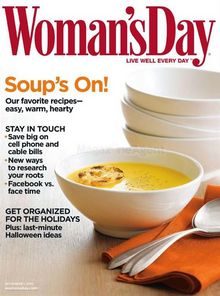Woman's Day
This article needs additional citations for verification. (September 2023) |
 November 2010 cover | |
| Content director | Meaghan Murphy |
|---|---|
| Categories | Home economics |
| Frequency | Monthly |
| Publisher | Hearst Magazines |
| Total circulation (2013) | 3,394,754[1] |
| Founded | 1931 |
| Country | United States |
| Based in | New York City |
| Language | English |
| Website | www |
| ISSN | 0043-7336 |
Woman's Day is an American women's monthly magazine that covers such topics as homemaking, food, nutrition, physical fitness, physical attractiveness, and fashion. The print edition is one of the Seven Sisters magazines. The magazine was first published in 1931[2] by The Great Atlantic & Pacific Tea Company; the current publisher is Hearst Corporation.
History
[edit]A&P began publishing the U.S. edition as a free in-store menu/recipe planner, calculated to make customers buy more by giving them meal ideas in an easy-to-read format available inside A&P grocery stores.
Following the 1936 opening of A&P's first modern supermarket (in Braddock, Pennsylvania), A&P expanded Woman's Day in 1937 through a wholly owned subsidiary, the Stores Publishing Company. Selling for five cents a copy (106¢ today), the magazine featured articles on childcare, crafts, food preparation and cooking, home decoration, needlework and health, plus a revival of cartoonist Walter Hoban's Jerry on the Job comic strip in a 1939 Grape-Nuts ad campaign.[3]
Sold exclusively in A&P stores, Woman's Day had a circulation of 3,000,000 by 1944. This had reached 4,000,000 by the time A&P sold the magazine to Fawcett Publications in 1958. By 1965, Woman's Day had climbed to a circulation of 6,500,000.
In a mid-1960s appeal to Madison Avenue, an ad for Woman's Day showed a friendly pharmacist named I.A. Morse next to copy that claimed:
So Woman's Day doesn't tell a lot of funny stories, and it doesn't run pictures of fashions its readers could never afford. Like I.A. Morse, Woman's Day -- more than any other magazine -- is a trusted advisor in the day in day out work that's a housewife's chosen profession. That's our profession. And we're proud of it. Like Doc Morse Woman's Day talks man to man to women.
Fawcett was sold to CBS in 1977, and CBS, in turn, sold its magazine division to a group led by division head Peter Diamandis, who renamed the group Diamandis Communications. In 1988 Woman's Day, along with the rest of Diamandis, was acquired by Hachette Filipacchi Médias which published the magazine from offices at 1633 Broadway in New York. Hearst Magazines bought the Hachette magazines in the US in 2011.
Editors
[edit]- Mabel Hill Souvaine (1943–1957)
- Eileen Tighe (1957–1966)
- Geraldine Rhoads (1966–1982)
- Ellen Levine (1982–1991)
- Jane Chesnutt (1991–2010)
- Elizabeth Mayhew (2010-2012)
- Susan Spencer (2012–2020)
- Meaghan Murphy (2020–present)
Notable staff
[edit]See also
[edit]References
[edit]- ^ "eCirc for Consumer Magazines". Audit Bureau of Circulations. June 30, 2013. Retrieved October 3, 2013.
- ^ "Top 100 U.S. Magazines by Circulation" (PDF). PSA Research Center. Retrieved February 6, 2016.
- ^ Gallery
- ^ "Jeanne Voltz, 81; Past Editor of Times' Food Section". Los Angeles Times. 2002-01-16. Retrieved 2023-09-30.
- ^ "Jeanne Appleton Voltz 1920-2002". University of Alabama. Retrieved 2023-09-30.
- ^ Voss, Kimberly Wilmot (April 2013). "Food Journalism or Culinary Anthropology? Re-evaluating Soft News and the Influence of Jeanne Voltz's Food Section in the Los Angeles Times". American Journalism. 29 (2): 66–91. doi:10.1080/08821127.2012.10677826. ISSN 0882-1127.
External links
[edit]- Monthly magazines published in the United States
- Women's magazines published in the United States
- Food and drink magazines published in the United States
- The Great Atlantic & Pacific Tea Company
- Hearst Communications publications
- Magazines established in 1931
- Magazines published in New York City
- Fawcett Publications
